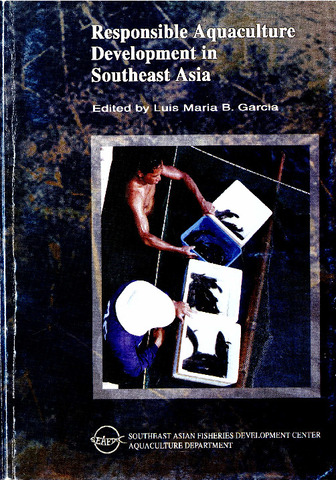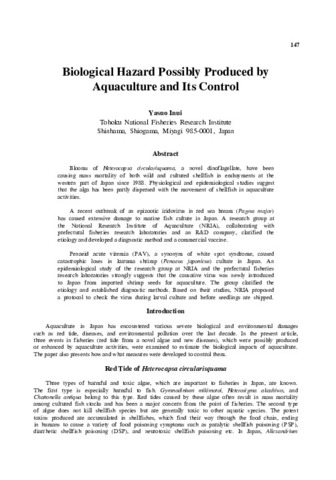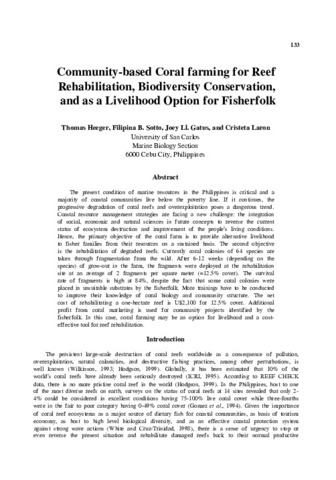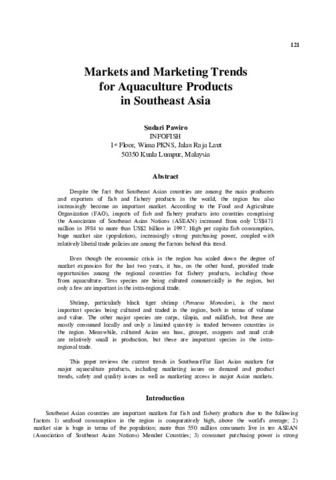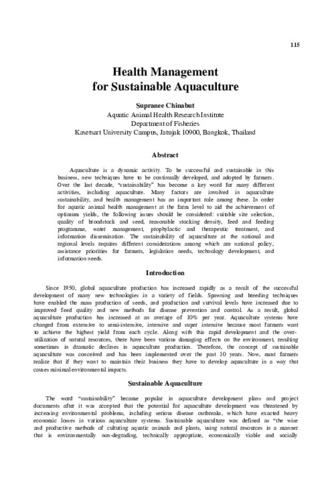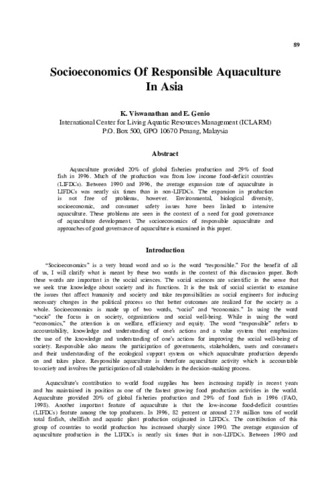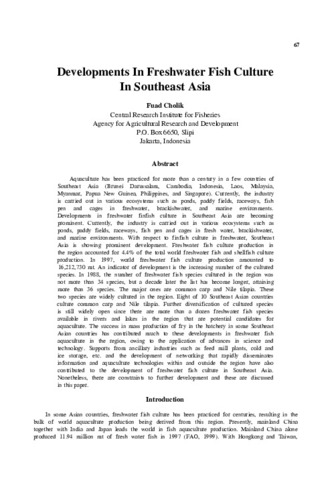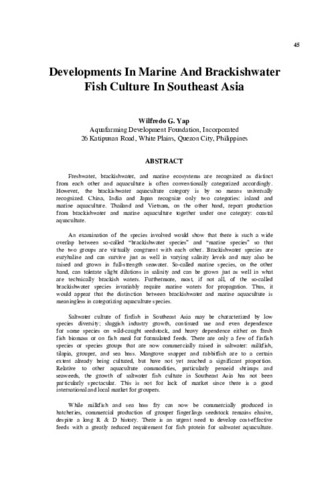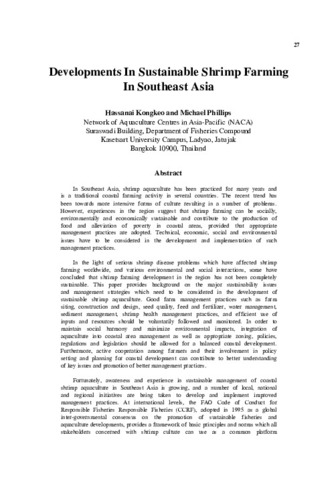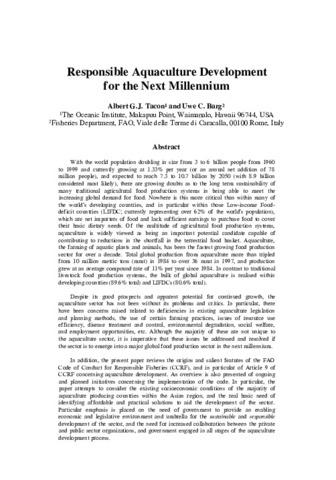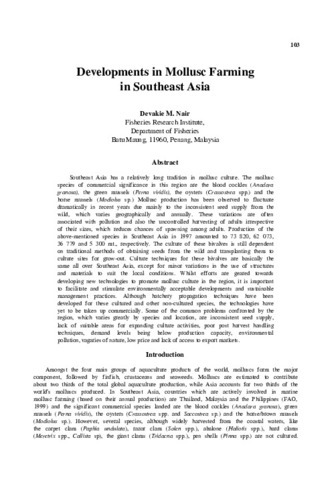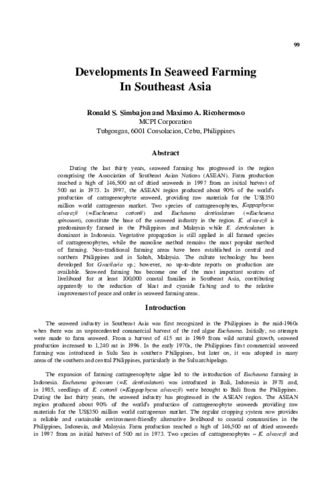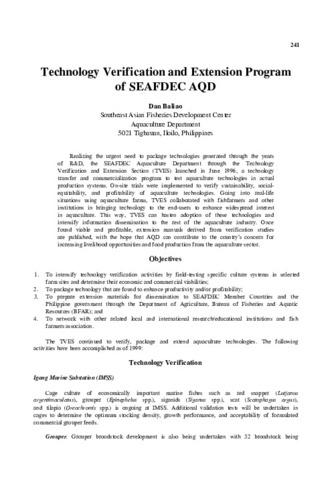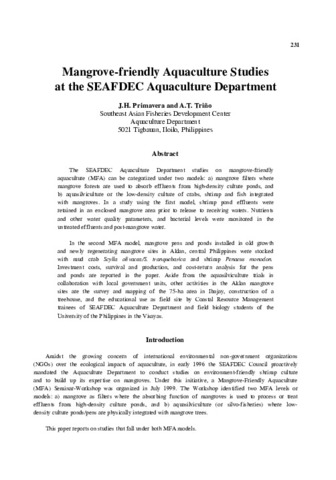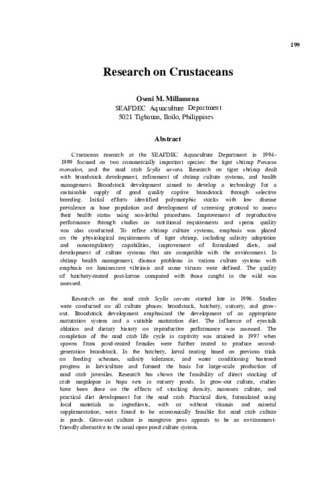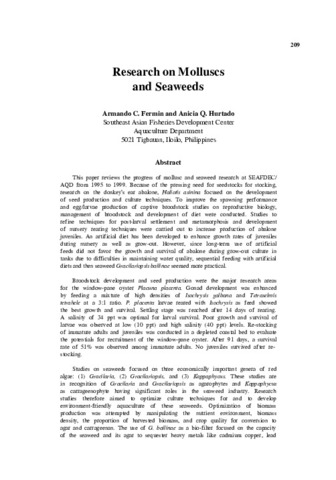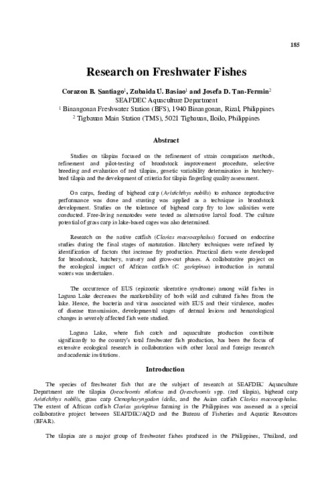ADSEA '99
Responsible aquaculture development in Southeast Asia. Proceedings of the Seminar-Workshop on Aquaculture Development in Southeast Asia
The Seminar-Workshop on Aquaculture Development in Southeast Asia (ADSEA) is a series conducted every three years for the formulation of the three-year research and development plan of the SEAFDEC Aquaculture Department. It was conceived as a forum to assess the contribution of the Department to the development of aquaculture in the region. ADSEA was convened in 1987, 1991, and 1994. In 1997, in lieu of the regular seminar-workshop, a survey of aquaculture research and training needs was conducted and the result was the basis for the 1998-2000 research and training program of the Department. This seminar-workshop (ADSEA '99) reviewed the recent developments in aquaculture and provided a forum to discuss strategies to ensure further development of responsible aquaculture in the region. Specifically, ADSEA '99 1) assessed the progress and developments of aquaculture technologies in the region, and research and development in the Department since 1995; 2) reviewed recent advances in sustainable and responsible aquaculture elsewhere in the world; and 3) identified strategies for sustainable and responsible aquaculture in the region. The contributions of selected participants during ADSEA '99 appear in this present volume.
Contents
-
Responsible aquaculture development for the next millennium
A. G.J. Tacon & U. C. Barg -
Developments in sustainable shrimp farming in Southeast
Asia
H. Kongkeo, H. & M. Phillips -
Developments in marine and brackishwater fish culture in Southeast
Asia
W. G. Yap -
Developments in freshwater fish culture in Southeast Asia
F. Cholik -
Developments in integrated aquaculture in Southeast Asia
C. K. Lin & Y. Yi -
Socioeconomics of responsible aquaculture in Asia
K. Viswanathan & E. Genio -
Developments in seaweed farming in Southeast Asia
R. S. Simbajon & M. A. Ricohermoso -
Developments in mollusc farming in Southeast Asia
D. M. Nair -
Health management for sustainable aquaculture
S. Chinabut -
Markets and marketing trends for aquaculture products in Southeast
Asia
S. Pawiro -
Community-based coral farming for reef rehabilitation, biodiversity
conservation and as
a livelihood option for fisherfolk
T. Heeger, F. B. Sotto, J. Ll. Gatus & C. Laron -
Biological hazard possibly produced by aquaculture and its
control
Y. Inui -
Environmental impacts of marine fish farming and their
mitigation.
R. S. S. Wu -
REVIEW OF RESEARCH AND DEVELOPMENT ACTIVITIES AT SEAFDEC/AQD
-
Research on marine fishes
J. D. Toledo -
Research on freshwater fishes
C. B. Santiago, Z. U. Basiao & J. D. Tan-Fermin -
Research on crustaceans
O. M. Millamena -
Research on molluscs and seaweeds
A. C. Fermin & A. Q. Hurtado -
Community-based Fishery Resources Management Project in
Malalison Island:
institutional
arrangements for fisheries co-management
R. F. Agbayani & A. S. Babol -
Mangrove-friendly aquaculture studies at the SEAFDEC Aquaculture
Department
J. H. Primavera & A. T. Triño -
Technology Verification and Extension Program of SEAFDEC AQD
D. Baliao
-
Research on marine fishes
- ADSEA ‘99 Priorities and Recommendations
- LIST OF PARTICIPANTS AND OBSERVERS
最新登録資料
-
Responsible aquaculture development in Southeast Asia: Proceedings of the seminar-workshop on aquaculture development in Southeast Asia
(Aquaculture Department, Southeast Asian Fisheries Development Center, 2001)This publication documents the proceedings and outputs of the tri-annual seminar-workshop on Aquaculture Development in Southeast Asia (ADSEA). This seminar, ADSEA 99, reviewed the recent developments in aquaculture and ... -
Environmental impacts of marine fish farming and their mitigation
(Aquaculture Department, Southeast Asian Fisheries Development Center, 2001)The environmental impact of marine fish farming depends on species cultured, culture method, stocking density, feed type, hydrography of the site, and husbandry practices. In all cultured systems, however, a very large ... -
Biological hazard possibly produced by aquaculture and its control
(Aquaculture Department, Southeast Asian Fisheries Development Center, 2001)Blooms of Neterocapsa circularisquama, a novel dinoflagellate, have been causing mass mortality of both wild and cultured shellfish in embayments at the western part of Japan since 1988. Physiological and epidemiological ... -
Community-based coral farming for reef rehabilitation, biodiversity conservation and as a livelihood option for fisherfolk
(Aquaculture Department, Southeast Asian Fisheries Development Center, 2001)The present condition of marine resources in the Philippines is critical and a majority of coastal communities live below the poverty line. If it continues, the progressive degradation of coral reefs and overexploitation ... -
Markets and marketing trends for aquaculture products in Southeast Asia
(Aquaculture Department, Southeast Asian Fisheries Development Center, 2001)Despite the fact that Southeast Asian countries are among the main producers and exporters of fish and fishery products in the world, the region has also increasingly become an important market. According to the Food and ... -
Health management for sustainable aquaculture
(Aquaculture Department, Southeast Asian Fisheries Development Center, 2001)Aquaculture is a dynamic activity. To be successful and sustainable in this business, new techniques have to be continually developed, and adopted by farmers. Over the last decade, sustainability has become a key word ... -
Socioeconomics of responsible aquaculture in Asia
(Aquaculture Department, Southeast Asian Fisheries Development Center, 2001)Aquaculture provided 20% of global fisheries production and 29% of food fish in 1996. Much of the production was from low income food-deficit countries (LIFDCs). Between 1990 and 1996, the average expansion rate of aquaculture ... -
Developments in integrated aquaculture in Southeast Asia
(Aquaculture Department, Southeast Asian Fisheries Development Center, 2001)Integrated aquaculture is inclusive of interactive utilization of resources and ecosystems in the artificial rearing of aquatic animals and plants. By the nature, purpose and scale of the operation, integrated fish culture ... -
Developments in freshwater fish culture in Southeast Asia
(Aquaculture Department, Southeast Asian Fisheries Development Center, 2001)Aquaculture has been practiced for more than a century in a few countries of Southeast Asia (Brunei Darussalam, Cambodia, Indonesia, Laos, Malaysia, Myanmar, Papua New Guinea, Philippines, and Singapore). Currently, the ... -
Developments in marine and brackishwater fish culture in Southeast Asia
(Aquaculture Department, Southeast Asian Fisheries Development Center, 2001)Freshwater, brackishwater, and marine ecosystems are recognized as distinct from each other and aquaculture is often conventionally categorized accordingly. However, the brackishwater aquaculture category is by no means ... -
Developments in sustainable shrimp farming in Southeast Asia
(Aquaculture Department, Southeast Asian Fisheries Development Center, 2001)In Southeast Asia, shrimp aquaculture has been practiced for many years and is a traditional coastal farming activity in several countries. The recent trend has been towards more intensive forms of culture resulting in a ... -
Responsible aquaculture development for the next millennium
(Aquaculture Department, Southeast Asian Fisheries Development Center, 2001)With the world population doubling in size from 3 to 6 billion people from 1960 to 1999 and currently growing at 1.33% per year (or an annual net addition of 78 million people), and expected to reach 7.3 to 10.7 billion ... -
Developments in mollusc farming in Southeast Asia
(Aquaculture Department, Southeast Asian Fisheries Development Center, 2001)Southeast Asia has a relatively long tradition in mollusc culture. The mollusc species of commercial significance in this region are the blood cockles (Anadara granosa), the green mussels (Perna viridis), the oysters ... -
Developments in seaweed farming in Southeast Asia
(Aquaculture Department, Southeast Asian Fisheries Development Center, 2001)During the last thirty years, seaweed farming has progressed in the region comprising the Association of Southeast Asian Nations (ASEAN). Farm production reached a high of 146,500 mt of dried seaweeds in 1997 from an initial ... -
Technology Verification and Extension Program of SEAFDEC AQD
(Aquaculture Department, Southeast Asian Fisheries Development Center, 2001)Realizing the urgent need to package technologies generated through the years of R&D, the SEAFDEC Aquaculture Department (AQD) through the TEchnology Verification and Extension Section (TVES) launched in June 1996, a ... -
Mangrove-friendly aquaculture studies at the SEAFDEC Aquaculture Department
(Aquaculture Department, Southeast Asian Fisheries Development Center, 2001)The SEAFDEC Aquaculture Department studies on mangrove-friendly aquaculture (MFA) can be categorized under two models: a) mangrove filters where mangrove forests are used to absorb effluents from high-density culture ponds, ... -
Research on crustaceans
(Aquaculture Department, Southeast Asian Fisheries Development Center, 2001)Crustacean research at the SEAFDEC Aquaculture Department in 1994-1999 focused on two commercially important species: the tiger shrimp Penaeus monodon, and the mud crab Scylla serrata. Research on tiger shrimp dealt with ... -
Research on molluscs and seaweeds
(Aquaculture Department, Southeast Asian Fisheries Development Center, 2001)This paper reviews the progress of mollusc and seaweed research at SEAFDEC AQD from 1995 to 1999. Because of the pressing need for seedstocks for stocking, research on the donkey s ear abalone, Haliotis asinina focused on ... -
Community-based Fishery Resources Management Project in Malalison Island: Institutional arrangements for fisheries co-management
(Aquaculture Department, Southeast Asian Fisheries Development Center, 2001)The paper discusses the monitoring mechanism of the SEAFDEC/AQD Community-based Fisheries Resources Management (CFRM) Project at Malalison Island in west central Philippines. The objective of the project was to learn from ... -
Research on freshwater fishes
(Aquaculture Department, Southeast Asian Fisheries Development Center, 2001)Studies on tilapias focused on the refinement of strain comparison methods, refinement and pilot-testing of broodstock improvement procedure, selective breeding and evaluation of red tilapias, genetic variability determination ...

